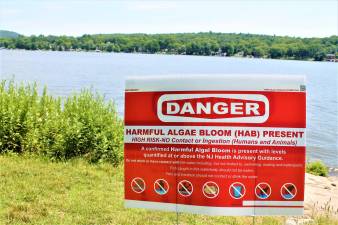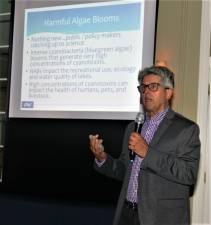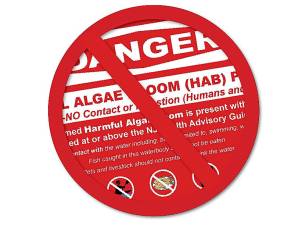Gov. Murphy announces plan to deal with Harmful Algal Blooms
West Milford. New Jersey Gov. Phil Murphy announced his plan Monday to help communities deal with Harmful Algal Blooms.

After a summer with devastating economic losses at the state’s two largest lakes due to Harmful Algal Blooms, Gov. Phil Murphy is taking steps to address the problem.
“The presence of Harmful Algal Blooms in New Jersey’s waterbodies severely impacts our public health and economy,” Gov. Murphy said when announcing his initiatives at a meeting with members of congress and local officials in Landing. “The rise of Harmful Algal Blooms is a global challenge and our initiative to reduce future blooms will allow us to protect the health of our residents, as well as the economies of our lake communities. I am grateful for the continued collaboration with our local, state, and federal partners to proactively address this environmental challenge and become a national model for reducing the occurrence of Harmful Algal Blooms.”
Murphy’s initiative calls for more than $13 million in state funding to help local communities battle the blooms, as well as forming a group of experts to study and monitor bloom events throughout the state by providing monitoring, testing and data management to better evaluate the state’s strategy in dealing with them.
In addition, the plan will work closely with the state Department of Environmental Protection to communicate with the affected communities, including holding two HAB summits in early 2020 to share information before the blooms form, usually in the warmer months.
“We will reduce harmful algal blooms by working closely with our local partners on prevention and treatment techniques, while relying on the best available science to clearly communicate risk to the public,” Department of Environmental Protection Chief of Staff Shawn LaTourette said. “Our new harmful algal bloom initiative will enhance the Department’s ability to evaluate statewide strategies and increase the capacity of lake communities to reduce future blooms.”
Last summer, the DEP issued “no-contact” advisories on both Lake Hopatcong and Greenwood Lake, the state’s two largest waterbodies.
The advisories caused a massive drop in summer tourism businesses along the lakes.
The Greenwood Lake advisory, issued in mid-July, was only completely lifted as of Nov. 7, according to the DEP.
DEP issued the advisories after cyanobacteria levels rose above 20,000 cells per milliliter of water at various testing locations on the lakes.
According to the DEP, there were more than 70 suspected blooms and 39 confirmed in 2019.
The blooms can create toxins that can be harmful to humans and animals, causing a variety of symptoms ranging from rashes to intestinal and kidney diseases, according to the DEP.
The funding piece of the plan is broken down to giving out $2.5 million in matching grants for HAB management, treatment, and prevention demonstration projects.
Those projects will accept proposals in December and offer 100 percent matching for an estimated $5 million in projects, according to the state.
Another $1 million will be given out in Watershed Grant projects to reduce “nonpoint” source pollution that brings the nutrients needed for the blooms to form.
Finally, $10 million will go to principal forgiveness projects that address the storm water infrastructure running into the lakes.
U. S. Rep. Josh Gottheimer, D-5, attended the announcement on Monday and said he is pleased with the state’s efforts.
“I’m very grateful for the partnership and investment the state is announcing today to prevent another summer of algae that wreaked havoc on our lakes, our businesses, our residents, and our broader community,” he said. “It will tackle everything from preventing run-off and improving sewer systems to prevention and treatment projects. Today’s actions are good for our environment, good for our economy, good for our eco-tourism, and good for the health and safety of our families. It’s a win-win-win.”
State Sen. Joe Peannacchio, R-26, who represents Lake Hopatcong and West Milford, the home of the New Jersey portion of Greenwood Lake, has been critical of the levels the DEP uses to issue the advisories, and hopes the new initiatives will become more balanced and nuanced before such advisories are issued.
“New Jersey lakes were closed this summer I believe due to faulty NJDEP protocols that were based on political science rather than actual science,” Pennacchio said. “Gov. Murphy’s commitment to us today to re-evaluate the state’s approach to preventing, monitoring, and communicating with the public about harmful algal blooms is welcomed and represents a total validation of the concerns we raised on behalf of families and businesses that were devastated by this summer’s unnecessary lake closures.”




